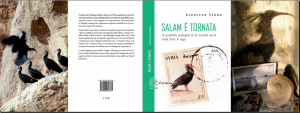A narrative book was published by Exorma (Roma, Italy) in November 2016 with the title “Salam e’ tornata” (in Italian language)

Hopefully it will be published in English soon.
The following is the synopsis.
“Salaam Has Returned” is a vividly intense and personal account of the author’s recent long-term experience in Syria. The story stems from everyday life on the front line of a major nature conservation effort that took place in the heart of a restless Middle East in the decade before national civil unrest erupted in 2011. In 2000, the author landed in Syria as a young and idealistic ecologist to take part in an international aid project aimed at creating a natural reserve in the desert surrounding Palmyra, a remote village, home to one of the most spectacular archaeological sites in the region.
At that time, Syria was still a sleepy dictatorship disguised as a republic. In its early stages, the project is mired in a labyrinth of corruption and bureaucracy. The author and his ragtag team of locals struggle for years until they realize a sensational naturalistic discovery that makes headlines around the world. They find the last wild colony in the Middle East of a critically endangered species: a magnificent and bizarre looking bird considered extinct in Syria for more than 70 years.
Sacred to the Egyptians and immortalized with its long hooked beak in a fine 4500-year old hieroglyph at the Temple of Horus in Edfu (see photo at the bottom of the document), the Northern Bald Ibis had long flown only in the imagination of naturalists and the faded memories of old Bedouins.
This book, through an engaging first-person recount, narrates the misadventures of that discovery, the excitement and the incredible obstacles this handful of nature enthusiasts faced to grant protection to the birds, the odyssey to track down their migratory route up to the Ethiopian highlands and the strenuous efforts to eventually identify the cause of their ineluctable decline. It is a story of perseverance through which the involved desert characters found new awareness of their environmental heritage.
The passion of these people for resuscitating this “Lazarus population” is an inspiring celebration of the resilience of nature, the power of persistence and the value of going your own way.
At the same time, these pages provide a detailed and ironic snapshot of how Syria was prior to the onset of the war – captured through the smoky lens of discussions in the tents of the Bedouin nomads or through life under the yoke of the notorious infamous secret service; through images from the country’s dusty streets and inside the luxurious palaces of Damascus’ upper echelons.
Salaam is the name of one of the ibises of the colony found in the Palmyra desert in 2002. Every spring when Salaam and her winged mates returned from their wintering grounds in Ethiopia, through a long and perilous migration, to breed on the cliffs of the Syrian desert, it signified a small victory. Her name in Arabic means “Peace”. During past recent years, she has stubbornly kept returning to her solitary nesting cliff to witness a land devastated by a brutal war.